Which Aster?
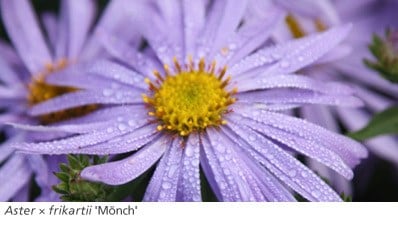
Heavy morning dews keep everything as fresh as a daisy, but finding the right daisy in a sea of varieties is the key to success. 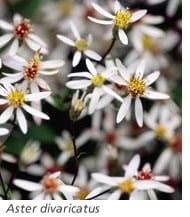 Michaelmas daisies for instance, grow in North America, Asia and Europe in a variety of locations. Some are dry, some alpine and some positively marshy. For many years the most popular Michaelmas daisies, or asters, were selected forms of the moisture-loving New York asters (A. novi-belgii), which are used to boggy conditions. They struggled to perform well in many gardens, developing unsightly mildew, and this gave the whole tribe a bad name. Michaelmas daisies for instance, grow in North America, Asia and Europe in a variety of locations. Some are dry, some alpine and some positively marshy. For many years the most popular Michaelmas daisies, or asters, were selected forms of the moisture-loving New York asters (A. novi-belgii), which are used to boggy conditions. They struggled to perform well in many gardens, developing unsightly mildew, and this gave the whole tribe a bad name.
Simply the Best
However there are lots of asters that are undemanding and reliably perennial, even in dry gardens. These are the ones to grow. The finest of all is Aster x frikartii ‘Monch’ and this will flower from July until late September, producing large lavender-lashed flowers with neat yellow middles. The flowers are enhanced by good, dark-green foliage, which never gets diseased, and the stems are strong enough not to need staking, despite the fact that this plant curtsies a little. Give it a front of border position for it always looks pristine. 'Mönch’, named after a Swiss mountain, was one of a series bred in 1921 by the Swiss nurseryman Frikart. He used an alpine Himalayan species (A. thomsonii) and a drought-tolerant Italian aster (A. amellus). This very difficult cross, only successfully made by Frikart, Alan Bloom and Wolley-Dod, produced a bombproof handsome aster that will thrive in any garden.
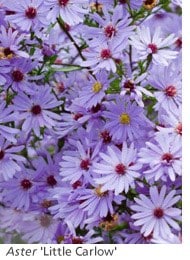 Quite different in form, but equally robust, is ‘Little Carlow’ a bushy aster with fine foliage and sprays of lavender-blue flowers that appear from buds stippled in red. In September light this aster glows with hundreds of tiny flowers on a rounded bush. It’s an excellent plant set back a little, on the corner of a border, or another prominent position where it assumes a rounded shape. Again it’s self-supporting. Quite different in form, but equally robust, is ‘Little Carlow’ a bushy aster with fine foliage and sprays of lavender-blue flowers that appear from buds stippled in red. In September light this aster glows with hundreds of tiny flowers on a rounded bush. It’s an excellent plant set back a little, on the corner of a border, or another prominent position where it assumes a rounded shape. Again it’s self-supporting.
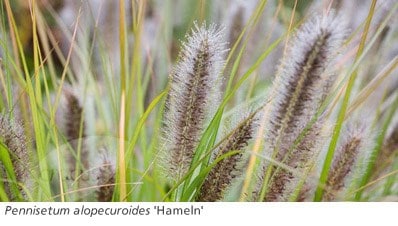 Forms of the September-flowering New England Aster, A. novae-angliae, have stiff, upright stems topped with clusters of nectar-rich flowers that pull in the butterflies. ‘Violetta’ has yellow-centred, deep-purple flowers, but like all New England asters the lower leaves can be unsightly following dry weather. This can be solved by placing another plant in front, such as the dusky pink to pigeon-breast grey Sedum ‘Matrona’. Or use Pennisetum alopecuroides 'Hameln', a hardy grass producing brown, furry, caterpillar-like flower spikes. Another solution is to cut back the front third of stems by two-thirds. These will still be green in September and it’s a technique you can also use with heleniums and phlox. However this does delay the flowers on the front third.
Forms of the September-flowering New England Aster, A. novae-angliae, have stiff, upright stems topped with clusters of nectar-rich flowers that pull in the butterflies. ‘Violetta’ has yellow-centred, deep-purple flowers, but like all New England asters the lower leaves can be unsightly following dry weather. This can be solved by placing another plant in front, such as the dusky pink to pigeon-breast grey Sedum ‘Matrona’. Or use Pennisetum alopecuroides 'Hameln', a hardy grass producing brown, furry, caterpillar-like flower spikes. Another solution is to cut back the front third of stems by two-thirds. These will still be green in September and it’s a technique you can also use with heleniums and phlox. However this does delay the flowers on the front third.
Coneflowers and Sneezeweeds

A perfect next door neighbour for the lavender flowers of Aster x frikartii 'Mönch’ is the crisp yellow and brown coneflower or rudbeckia. The neatest and most consistent are Rudbeckia fulgida var. deamii (Deam’s coneflower) and Rudbeckia fulgida var. sullivantii 'Goldsturm'. The latter, a mouthful of a name, is usually seed-raised so may be variable. Flower colour and size are slightly different. If a smaller, neater orange-yellow is preferred opt for Deam’s coneflower (R. fulgida var. deamii). If you want larger-rayed, less-formal, yellow flowers opt for ‘Goldsturm’, This was first spotted at a botanic garden in Czechoslovakia in 1937 by Heinrich Hagemman, an employee of the famous German nurseryman Karl Foerster. Both rudbeckias deserve a place in any garden, but ‘Goldsturm’ is better in naturalistic planting schemes, whilst the crisper Deam’s coneflower looks sprucer and sharper, like James Bond in a dinner-jacket.
 Taller by far are the leggy forms of Rudbeckia laciniata, which can reach man height or more. ‘Goldquelle’ is the double form and ‘Herbstsonne’ a simple single that has almost apple-green cones. Both are superb and both stay in clumps, without running into other things, as so many tall yellow daisies are wont to do. Both will create interesting winter silhouettes. Almost as tall is the Ratibida pinnata, a pale-yellow coneflower from Missouri that deserves to be grown more widely for its droopy-petalled flowers have great charm. This is a perfect foil for tall moor grasses, named forms of Molinia caerulea subsp. arundinacea. ‘Transparent’ will provide a beaded veil that moves and sways as the tiny beads darken to slate-black. ‘Poul Petersen’ is a new one, with more upright purple awns that fade to mink-brown in winter. Or use ‘Heidebraut’, for its all-brown spikelets that gently bend and sway. Finally find room for the Korean feather grass, Calamagrostis brachytricha, because its glossy feathers are a soft mauve in early autumn and this flatters every aster going. Taller by far are the leggy forms of Rudbeckia laciniata, which can reach man height or more. ‘Goldquelle’ is the double form and ‘Herbstsonne’ a simple single that has almost apple-green cones. Both are superb and both stay in clumps, without running into other things, as so many tall yellow daisies are wont to do. Both will create interesting winter silhouettes. Almost as tall is the Ratibida pinnata, a pale-yellow coneflower from Missouri that deserves to be grown more widely for its droopy-petalled flowers have great charm. This is a perfect foil for tall moor grasses, named forms of Molinia caerulea subsp. arundinacea. ‘Transparent’ will provide a beaded veil that moves and sways as the tiny beads darken to slate-black. ‘Poul Petersen’ is a new one, with more upright purple awns that fade to mink-brown in winter. Or use ‘Heidebraut’, for its all-brown spikelets that gently bend and sway. Finally find room for the Korean feather grass, Calamagrostis brachytricha, because its glossy feathers are a soft mauve in early autumn and this flatters every aster going.
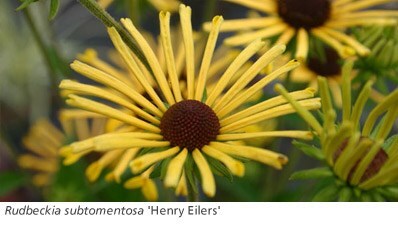
Metre high yellow daisies are also useful and the black-stemmed wiry profile of Heliopsis helianthoides var. scabra ‘Summer Nights’ is a must. Its single daisies float above the planting on their sultry stems, like small spinning plates. The quilled petals of Rudbeckia subtomentosa ‘Henry Eilers’ are another great addition. This was spotted in a remnant of American prairie in southern Illinois, right by a railway, and named for the retired nurseryman who found it. The leaves smell of vanilla when crushed.
Add a Touch of Warm Red

Ignite those golden yellows with a touch of rufous-red by growing a helenium or two. Taller varieties flower later than their shorter cousins. ‘Rauchtopas’, meaning smoky topaz, has petals swept up like the rim of a sombrero, showing warm orange-red on the undersides. The warm mahogany ‘Moerheim Beauty’, bred in the 1930s at Ruys’ Royal Moerheim Nurseries in The Netherlands, has the flouncing skirts of a flamenco dancer in full flow. This will bloom late, right up until October if happy, reaching a metre in good soil, and it’s still the best of the bunch.
Uniting Your Planting
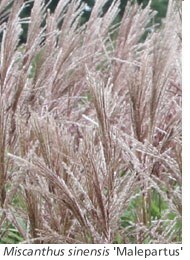 Finally pull everything together by threading graceful forms of tall Miscanthus sinensis through your planting, for their plumes of flower last into winter. Classic varieties include ‘Malepartus’, great for larger areas and grown for its purplish awns, which turn cotton-wool white and fluffy in winter, or ‘Gracillimus’ - it may be shy to flower, but it is gorgeous for its foliage. ‘Kleine Silberspinne’ is shorter with rose-pink awns that age to silver and ‘Kleine Fontäne’ has floppier paler pink awns that are held well above the foliage. These will all shine and shimmy, particularly at sunset. |
Five tips for September
 |
Establish a Clematis
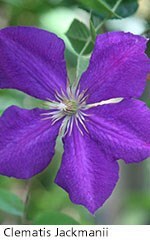 September is the best month to plant a clematis because the soil is still warm enough to encourage root growth. Try a Viticella for late-summer froth. None is quite as good as the old Elizabethan variety 'Purpurea Plena Elegans' with its dusky pink double flowers that lightly scramble like a rambling rose. Others include 'Polish Spirit' (a single late with purple blooms) and 'Etoile Violette' (a starry purple with a golden boss) once voted the top clematis by the Clematis Society. The spring-flowering 'Propertius', an Atragene, produces a ragged pale-pink skirt with a cream petticoat in April. Like all spring-flowering clematis it needs good drainage and no pruning.
September is the best month to plant a clematis because the soil is still warm enough to encourage root growth. Try a Viticella for late-summer froth. None is quite as good as the old Elizabethan variety 'Purpurea Plena Elegans' with its dusky pink double flowers that lightly scramble like a rambling rose. Others include 'Polish Spirit' (a single late with purple blooms) and 'Etoile Violette' (a starry purple with a golden boss) once voted the top clematis by the Clematis Society. The spring-flowering 'Propertius', an Atragene, produces a ragged pale-pink skirt with a cream petticoat in April. Like all spring-flowering clematis it needs good drainage and no pruning.
|
 |
Give plants a trim
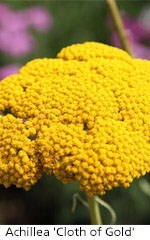
Lots of early-flowering plants may have become straggly over the summer and they need cutting back hard now in order to form a tight cushion that will overwinter. These include perennial violas, achilleas and anthemis. This short back and sides will improve their chances of overwintering greatly.
|
 |
Divide if Necessary
Autumn-flowering plants cannot be divided when flowering, or just after flowering, because they would perish in winter time due to lack of root. The knack is to catch them just as they break into growth in spring. It’s easy to forget which clumps need attention. Mark them now, either with two canes, or two bright labels. Then when spring comes you’ll know where to dig. Most things can be pulled apart easily, or separated with two forks. If you have lots replant the outer pieces: they have more vigour. Plants that flower before Midsummer’s Day (approximately June 21st) can be tackled now. Only divide if your plant is going, or has gone backwards, or if you need more.
|
 |
Tulip Bulbs
 Order your tulip bulbs now, but hold off on the planting until the weather has turned cold because warm temperatures encourage a fungal disease called Tulip blight (Botrytis tulipae). All other bulbs can be planted now though, to a depth of twice to three times the size of the bulb. Tulips should be planted in November, or even later. Order your tulip bulbs now, but hold off on the planting until the weather has turned cold because warm temperatures encourage a fungal disease called Tulip blight (Botrytis tulipae). All other bulbs can be planted now though, to a depth of twice to three times the size of the bulb. Tulips should be planted in November, or even later.
|
 |
Winter Salads
 If you have a greenhouse full of tomatoes make use of it in winter by sowing winter salads in the middle of this month. These can be sown in trays and then bedded out to provide leaves throughout winter. Endive, chicory, winter lettuce, rocket, mustard and mizuna are among the best. If you like hot and spicy opt for mixed oriental leaves, or make your own 'softer on the palate mixture' using lettuce 'Winter Density', lettuce 'All Year Round' and rocket. Alternatively, sow Franchi's misticanza mixed salad leaves - a whopping 6000 seeds for £1.98 - these will keep you going until next spring. If you have a greenhouse full of tomatoes make use of it in winter by sowing winter salads in the middle of this month. These can be sown in trays and then bedded out to provide leaves throughout winter. Endive, chicory, winter lettuce, rocket, mustard and mizuna are among the best. If you like hot and spicy opt for mixed oriental leaves, or make your own 'softer on the palate mixture' using lettuce 'Winter Density', lettuce 'All Year Round' and rocket. Alternatively, sow Franchi's misticanza mixed salad leaves - a whopping 6000 seeds for £1.98 - these will keep you going until next spring. |
|

















